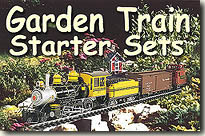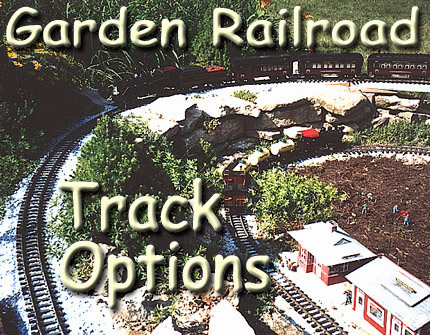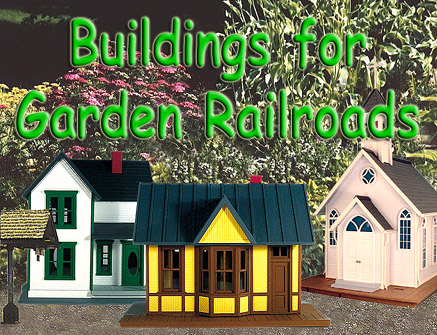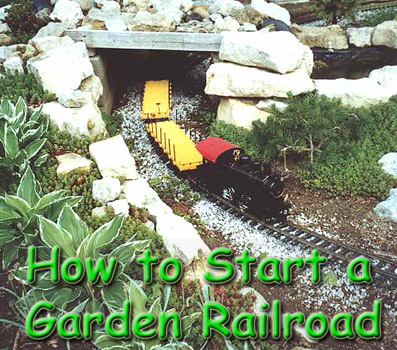What do I Need To Get Started?
 Other than a place to put your railroad, you need a Large Scale starter set made of weather-resistant materials such as those listed on our
Large Scale Starter Set page. These starter sets include a small circle of track and a power supply, so you can set up and run your train as soon as you get the box home. Other than a place to put your railroad, you need a Large Scale starter set made of weather-resistant materials such as those listed on our
Large Scale Starter Set page. These starter sets include a small circle of track and a power supply, so you can set up and run your train as soon as you get the box home.
 Trains look better and run better on larger curves, so consider saving the track that came with the starter set to use for holiday displays and buy a bigger circle of track to use outside. If you have the room, consider a
5'-diameter track circle, or better yet, a 10'-diameter track circle. Yes, a 31.4'-long "railroad" may seem big while you have a box of track in the house, but you'll find that it looks "about right" in your yard, as long as you can fit it in.) Trains look better and run better on larger curves, so consider saving the track that came with the starter set to use for holiday displays and buy a bigger circle of track to use outside. If you have the room, consider a
5'-diameter track circle, or better yet, a 10'-diameter track circle. Yes, a 31.4'-long "railroad" may seem big while you have a box of track in the house, but you'll find that it looks "about right" in your yard, as long as you can fit it in.)
You can also extend either circle into an oval with 1', 2', 3', or 5' pieces. Our Track Options page describes many kinds of pieces that have been available in the last few years and may be available again soon.
The power supply that comes with your train set will run a relatively small railroad fine outdoors as long as you make good connections between the rails (AristoCraft rails screw together, for example) and occasionally wipe the rails to keep them clean.
Other than this minimal investment in your train, you'll also spend money on such items as gravel, lumber, mulch, and plants as your railroad takes shape.
What If I Just Want To Try Things Out Before I Get Out the Shovel?
If you just want to get a "feeling" for how a train would look in your back yard, you can always start out with an oval of track on the patio. If you want the track in your yard instead, lay your track out someplace flat, then buy some fine crushed (not rounded) gravel. Any crushed gravel in which most or all of the pieces are smaller than 1/4" will do fine. (I use crushed granite chicken grit that I buy from the feed store, but you may be able to find a cheaper and more convenient source near your home.) You can't use rounded gravel such as "pea gravel" since it won't stay in place and support your track.
Pour the gravel on the track until the track is buried an inch or more deep. Then, shaking the track lightly, pull the track up through the gravel until only the top of the ties show. Pull any large pieces out from between the rails, then use a broom to "dust" off the ties and even out the gravel. Applying gravel to hold the track in place is called "ballasting." Add more gravel to any low places to make the track more even, wipe the top of the rails clean, set out the train, hook up the power, and watch it run.
What If I Want Something More Permanent?
First of all, consider starting off relatively small, with a railroad you can get running in a few weeks and extend later. This helps you keep from creating an empire too large to maintain properly at first, or getting discouraged if cold weather sets in before you get your trains running. If you can raise your railroad a foot or two off the ground, you'll find that it makes maintenance easier and allows visitors to see something besides the roofs of your trains and buildings, but many fine railroads are installed at ground level, so don't let that hold you back.
While you're planning your railroad, don't forget to plan the garden around it. A well-designed garden with a relatively small amount of "train stuff" is often more rewarding than a bunch of "train stuff" shoehorned into a badly-designed plot. For one thing, the garden is there 12 months a year, even on days you don't have a chance to run trains. Many techniques used by rock gardeners apply equally to garden railroads; in fact, learning about rock gardens will help you design your railroad as much as learning about trains.
There are almost as many ways to build a garden railroad as there are garden railroads, but you might want to start with one of the two most common methods.
Ground-Level Trench Roadbed
The most common ground-level railroad is built by digging a trench 5" wide and 4-6" deep, filling it with crushed gravel, then laying the track on top of the gravel and ballasting it by pouring a thin layer of fine crushed gravel on top of it and sweeping the excess out from between the rails.
One popular variation of this method is to use rock garden or retaining wall techniques to build a raised area, truck in and tamp down a few cubic yards of dirt, then dig the trench in the raised area. This method appeals to people who want a raised railroad and aren't entirely comfortable with the carpentry involved in the method described below. However, the new soil will keep settling for a few years, no matter how much you tamp it down, so you'll want to keep some extra ballast on hand until it stabilizes. |
 |
Raised Pressure-Treated Roadbed
 The most common raised railroad is made by making a wooden "roadbed" out of 2x6" pressure-treated lumber, connected by 1x6" "plates" and supported on 4x4" posts. The length and angle of each 2x6" piece you cut depends on the kind of track you're using, but once you've cut a few, and tried them out to make certain you're doing it right, the rest go very quickly. Each piece of 2x6" is fastened to the next by a foot-long 1x6" plate that goes under the 2x6". Most people like to assemble three or four lengths of 2x6" together with the 1x6" plates and lay some track on them temporarily to make certain they've measured right before they fasten the whole thing together. This also gives you a chance to lay the completed roadbed out on the ground and doublecheck where your post holes will go. If you don't plan to backfill at all, you may consider using DekBlocks or a similar product to support your posts, although you'll need to cross-brace between the posts if you raise the railroad more than 24" from the ground. One you get your superstructure established, you may cut off any objectionable corners of the 2x6s or 1x6s with a power saw. Don't nail or screw your track to the wood; the brass expands at a different rate than the wood and may pull the rails away from the ties if they're fastened down. You could wire the ties down loosely every so many feet, if you're paranoid about the track slipping off the roadbed, although that seldom happens, and almost never happens to track that has been backfilled and ballasted. The most common raised railroad is made by making a wooden "roadbed" out of 2x6" pressure-treated lumber, connected by 1x6" "plates" and supported on 4x4" posts. The length and angle of each 2x6" piece you cut depends on the kind of track you're using, but once you've cut a few, and tried them out to make certain you're doing it right, the rest go very quickly. Each piece of 2x6" is fastened to the next by a foot-long 1x6" plate that goes under the 2x6". Most people like to assemble three or four lengths of 2x6" together with the 1x6" plates and lay some track on them temporarily to make certain they've measured right before they fasten the whole thing together. This also gives you a chance to lay the completed roadbed out on the ground and doublecheck where your post holes will go. If you don't plan to backfill at all, you may consider using DekBlocks or a similar product to support your posts, although you'll need to cross-brace between the posts if you raise the railroad more than 24" from the ground. One you get your superstructure established, you may cut off any objectionable corners of the 2x6s or 1x6s with a power saw. Don't nail or screw your track to the wood; the brass expands at a different rate than the wood and may pull the rails away from the ties if they're fastened down. You could wire the ties down loosely every so many feet, if you're paranoid about the track slipping off the roadbed, although that seldom happens, and almost never happens to track that has been backfilled and ballasted.
I've Got My Train Running; Now What?
Now comes the gardening part of garden railroading. If you already have some plants that you think will look nice near your train, bring them over. If you want plants that will help your train look like it is running past real forests and farms, look for low-growing thymes and sedums (folks in warm climates may also use Corsican Mint and Baby Tears) to green up your lawns and meadows. To fill out your forests, look for miniature, dwarf, and low-growing conifers such as Dwarf Alberta Spruce, Dwarf Procumbens Juniper, and small Laceleaf Japanese Maple. And, when you're starting out, consider using landscaping fabric and mulch everywhere you don't have something specifically planted; otherwise you could find yourself spending more time weeding than you do running trains.
 To give your trains a reason to run, you can add stations and other structures from our Garden Railroad Buildings page. In addition the Family Garden Trains Primer pages include many great suggestions for To give your trains a reason to run, you can add stations and other structures from our Garden Railroad Buildings page. In addition the Family Garden Trains Primer pages include many great suggestions for
|
























 and
Garden Train Store(tm)
and
Garden Train Store(tm)








